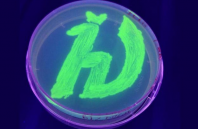A team of biophysicists from the Moscow Institute of Physics and Technology (MIPT; Moscow, Russia) and colleagues from France and Germany has created a new fluorescent protein that not only glows when irradiated with ultraviolet and blue light, it is exceedingly small and stable under high temperatures. The research team believes the protein holds promise for fluorescence microscopy, a technique being used in research on cancer, infectious diseases, and organ development.
Fluorescence microscopy is a method for studying living tissue that relies on induced luminescence. After being exposed to laser radiation at a particular wavelength, some proteins emit light at a different wavelength. This induced glow can be analyzed using a special microscope. Researchers append such fluorescent proteins to other proteins via genetic engineering to make the latter ones visible to the microscope and observe their behavior in cells.
Up until now, the fluorescent proteins used for such observations had several flaws. They were vulnerable to heat, fairly bulky, and only glowed in the presence of oxygen.

 (585) 768-2513
(585) 768-2513

